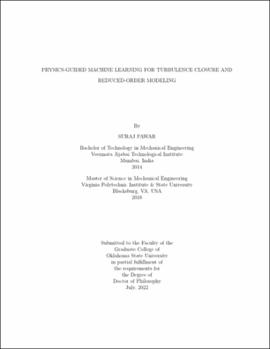| dc.contributor.advisor | San, Omer | |
| dc.contributor.author | Pawar, Suraj | |
| dc.date.accessioned | 2023-04-05T16:21:11Z | |
| dc.date.available | 2023-04-05T16:21:11Z | |
| dc.date.issued | 2022-07 | |
| dc.identifier.uri | https://hdl.handle.net/11244/337310 | |
| dc.description.abstract | A recent advance in scientific machine learning has started to show promising results in fluid mechanics. Despite their early success, the application of data-driven methods to turbulent flow simulation is non-trivial due to underlying highly nonlinear multiscale interactions. Here we present novel physics-guided machine learning (PGML) approaches for turbulence closure model discovery and model order reduction of complex multiscale systems. Our turbulence closure model discovery approach is based on exploiting big data without relying on underlying turbulence physics and learning from physical constraints. Specifically, we propose a frame invariant neural network model that can incorporate physical symmetries as inductive biases and illustrates its stable performance in the coarse-grid simulation without any kind of post-processing of the predicted subgrid-scale closure model. The frame invariant SGS model guarantees desired physical constraints without the need for any regularization terms and ultimately generalizes to different initial conditions and Reynolds numbers. To achieve data-efficient training and improved generalization, we propose a concatenated neural network with an uncertainty quantification mechanism that leverages information from hierarchies of models. The concatenated neural network is based on embedding information from cheap to evaluate low-fidelity approximations into the certain hidden layer of the neural network both during training and deployment. This framework is demonstrated for a range of problems, including turbulent boundary layer reconstruction, and reduced-order modeling of the vortex merging process. Furthermore, we investigate the seamless integration of sparse and noisy observations into non-intrusive reduced-order models, and hybrid models where the dynamical core of the system is modeled using the known governing equations, and the subgrid-scale processes are modeled using a deep learning model. To summarize, this work builds a bridge between extensive physics-based theories and data-driven modeling paradigms and paves the way for using hybrid physics-informed learning algorithms to generate predictive technologies for turbulent fluid flows. | |
| dc.format | application/pdf | |
| dc.language | en_US | |
| dc.rights | Copyright is held by the author who has granted the Oklahoma State University Library the non-exclusive right to share this material in its institutional repository. Contact Digital Library Services at lib-dls@okstate.edu or 405-744-9161 for the permission policy on the use, reproduction or distribution of this material. | |
| dc.title | Physics-guided machine learning for turbulence closure and reduced-order modeling | |
| dc.contributor.committeeMember | Santhanakrishnan, Arvind | |
| dc.contributor.committeeMember | Kara, Kursat | |
| dc.contributor.committeeMember | Ku, JaEun | |
| osu.filename | Pawar_okstate_0664D_17728.pdf | |
| osu.accesstype | Open Access | |
| dc.type.genre | Dissertation | |
| dc.type.material | Text | |
| dc.subject.keywords | data assimilation | |
| dc.subject.keywords | deep learning | |
| dc.subject.keywords | large eddy simulation | |
| dc.subject.keywords | model order reduction | |
| dc.subject.keywords | multi-fidelity data fusion | |
| dc.subject.keywords | physics-informed machine leanring | |
| thesis.degree.discipline | Mechanical and Aerospace Engineering | |
| thesis.degree.grantor | Oklahoma State University | |
